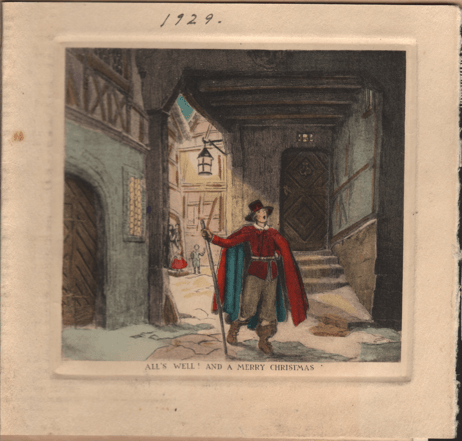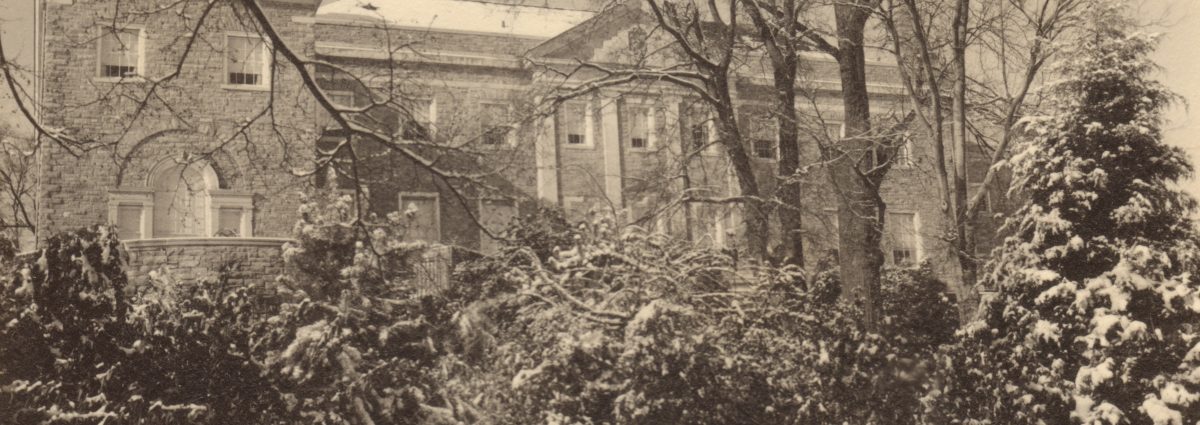“There is something in the very season of the year that gives a charm to the festivity of Christmas.”
“Old Christmas,” The Sketchbook of Washington Irving, 1819-20
Seasonal festivity brightens the year’s shortest days at the approach of a holiday that combines the deeply sacred and secular as well. In 1928, the city of Nashville first launched its Christmas Season with a downtown parade, and Tennessee’s Legislative Plaza glowed with holiday lights and gigantic letters that blazoned, MERRY CHRISTMAS. The city thus joined the national celebration of the Bethlehem Nativity in tandem with gift giving, Christmas cards, lighted fir trees, and the North Pole from which Santa Claus would alight in his toy-filled sleigh pulled by reindeer, thanks mainly to Clement C. Moore’s A Visit from St. Nicholas (1820), better known as “The Night Before Christmas.”
By 1933, the Cheek family had settled into their country estate, Cheekwood, and Mrs. Leslie Cheek—Mabel— began her holiday plans, writing to daughter Huldah of a “delicious” dessert (“which I will try out on you at Christmas”) and posting her letter to her daughter at boarding school in Pennsylvania: “MAIL EARLY FOR CHRISTMAS.” Two years later, Huldah’s “Christmas list” perplexed her mother, who found just one item, a “pajama suit” to be a suitable holiday gift.


Mabel customarily penned letters to Huldah and to her son, Leslie, Junior, in her favorite room at Cheekwood, the library, where she worked at her desk of inlaid woods. On the library shelves were the complete writings of two authors who might be dubbed founding fathers of the Yuletide holiday: Charles Dickens and Washington Irving. The American, Irving (b. 1783), and his English counterpart, Dickens (b.1812), were both represented at Cheekwood in leather-bound volumes that paid tribute to their status as literary figures of consequence. Both honed their skills in tales of a heart-warming Yuletide holiday that established the tradition with values of charity, friendship, and festivity as well.
Dickens’s A Christmas Carol (1843) is the better-known story of the impoverished Cratchit family, their hobbled son, Tiny Tim, and the miserable and miserly Ebenezer Scrooge who finally grasps his mortality and the imperative of empathy and generosity. A Christmas Carol was first brought to the silver screen in movie theaters in the 1938 production, starring Reginald Owen as Scrooge and Terry Kilburn as Tiny Tim.
Washington Irving’s “Old Christmas” predates A Christmas Carol by two decades and situates American readers in England “of yore,” harkening to an era of the English Squire’s country house and nearby village, where friends and family gather at the glowing hearth, attend services at the nearby cathedral where the choir sings in “triumphant harmony,” and on Christmas Day feast on roasted fowl and puddings in a spirit of merriment and fellowship.
It has been noted that, just as Charles Dickens presented a tale applicable to America, so Washington Irving’s “Old Christmas” deliberately appealed to the U.S. to ally with England by setting aside the rancor generated by the War of 1812, which stung in recent memory. Irving’s “Old Christmas” was thus a holiday appeal for peace in the guise of a yuletide reminiscence of Old England at its best.
Dickens, Irving, and a Cheek family Christmas coalesce in the WWII years of the 1940s, when Huldah’s husband, Walter Sharp, chronicled the family Christmas of 1944 in a lengthy letter to his mother in Franklin, Tennessee. Serving as a US Army Lieutenant stationed in Fort Sam Houston, Texas, Walter described a Texas Christmas with Huldah, their infant, Leslie, and his mother-in-law, Mabel Cheek. An old electric train was resuscitated in this moment when wartime production mandated that viable metals serve the war effort, though the baby preferred to “cuddle” a toy lamb. Walter continues, “Huldah gave me a lovely vase in Steuben glass, which is the finest American glass” and concludes, “Of course we missed all of you at Christmas, but, curiously, you didn’t seem so very far away….It was just as if we could run around the corner and there you all would be.”
There you all would be…. In place and in mind, those words speak volumes over the holidays, from years gone by to the farthest future.


Blog post provided by Cheekwood’s Writer-in-Residence, Cecelia Tichi, Ph.D.
Cecelia Tichi is an award-winning author and Professor of English and American Studies Emerita at Vanderbilt University. Her books span American literature and culture from colonial days to modern times, but her recent work draws upon the Gilded Age (post-1870) that prompted her book on Jack London and another on seven activists in that tumultuous era.
Cecelia’s research and teaching inspired What Would Mrs. Astor Do? The Essential Guide to the Manners and Mores of the Gilded Age, followed by Gilded Age Cocktails and Jazz Age Cocktails , which set the stage for her mystery crime novels that boast “Gilded” in each title.
Cecelia can be followed on her website: https://cecebooks.com/
